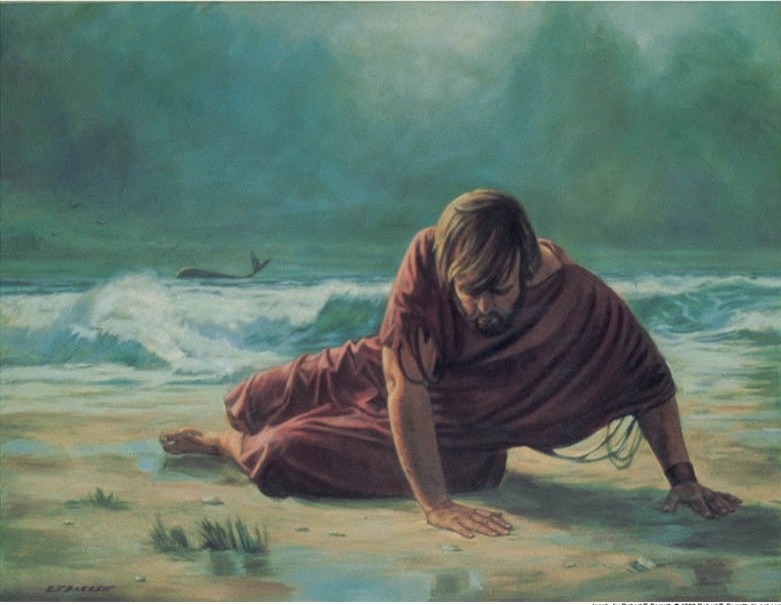In the Gospels, Simon Peter is a central figure, known for his passionate declarations and sometimes equally dramatic missteps as a disciple of Jesus. You might know him as Peter, the rock upon which Jesus said he would build his church. But have you ever paused to consider his full name as it appears in Matthew 16:17? Jesus addresses him, saying, “Blessed are you, Simon Bar-Jonah!” This inclusion of “Bar-Jonah” – meaning “son of Jonah” – is more than just a genealogical detail; it’s a significant piece of his identity woven into the fabric of the Gospel narrative.
 Depiction of Jonah and the Whale
Depiction of Jonah and the Whale
Unveiling “Bar-Jonah”: More Than Just a Patronymic
To understand the weight of “Bar-Jonah,” we must first recognize that in Aramaic, “Bar” simply signifies “son of.” Therefore, “Bar-Jonah” directly translates to “son of Jonah.” While seemingly straightforward, the question arises: which Jonah is this referring to? It’s crucial to clarify that this isn’t necessarily a direct link to Jonah the prophet, famous for his encounter with the great fish and his mission to Nineveh. Jonah was actually a relatively common name in Jewish culture during that period.
Therefore, when Jesus calls Simon “Bar-Jonah,” he is likely using Simon’s everyday name, identifying him in the customary way of the time – by referencing his father. Just as we might say “John, son of David,” “Simon Bar-Jonah” was simply how Simon was known in his community. However, given the context within Matthew’s Gospel and the broader biblical narrative, the connection to Jonah the prophet becomes an intriguing layer to explore, particularly when considering the “sign of Jonah” mentioned by Jesus earlier in the same chapter.
The Sign of Jonah and Echoes in Peter’s Story
Interestingly, just a few verses before Jesus blesses Simon as “Bar-Jonah,” he uses the phrase “the sign of Jonah” when speaking to the Pharisees and Sadducees (Matthew 16:4). This is a reference back to Matthew 12:40, where Jesus explicitly states, “For just as Jonah was three days and three nights in the belly of the great fish, so will the Son of Man be three days and three nights in the heart of the earth.” The sign of Jonah, in this context, is a clear prophecy of Jesus’s death and resurrection.
The repetition of “Jonah” in close proximity to naming Simon “Bar-Jonah” might not be coincidental within the carefully constructed narrative of Matthew’s Gospel. It invites us to consider parallels between Jonah’s story and Peter’s journey as a disciple.
Think about Jonah. God gave him a clear mission, but Jonah famously disobeyed and fled in the opposite direction. This disobedience led him into the belly of the great fish, a dark and symbolic place of confinement and repentance. Similarly, Peter, after his powerful confession of Jesus as the Christ, receives a new name, “Peter,” meaning “rock,” signifying his foundational role in the church. Yet, this “rock” falters. Just a short time later, Peter rebukes Jesus and is himself rebuked sharply (Matthew 16:23). Even more dramatically, in the hours leading up to Jesus’s crucifixion, Peter denies knowing Jesus three times, a profound failure in his commitment. This denial can be seen as Peter’s own “Jonah moment,” a time of spiritual darkness and sinking despair.
Restoration on the Shore: From “Son of Jonah” Back to “Peter”
The connection deepens when we look at Peter’s restoration after the resurrection, as recorded in John 21. This scene is rich with echoes of Jonah’s narrative. Following his denial and filled with remorse, Peter must have felt lost and unworthy, perhaps feeling like he was in his own “belly of the fish.” But just as Jonah was vomited onto the shore and given a second chance, Jesus meets Peter on the shore of the Sea of Galilee.
The details of this encounter are striking. There’s a charcoal fire, reminiscent of the fire where Peter stood when he denied Jesus (John 18:18). There are fish, drawing a connection to Peter’s life as a fisherman and perhaps subtly alluding to Jonah and the sea. Jesus invites Peter to bring some of the fish they’ve caught and then, in a powerful act of restoration, Jesus asks Peter three times, “Do you love me?” This threefold affirmation directly counters Peter’s threefold denial. And just as God recommissioned Jonah, Jesus reinstates Peter, commanding him, “Follow me,” echoing his original call in Matthew 4:19.
In this restoration, Peter moves beyond his “son of Jonah” moment of failure. He is reaffirmed in his role as “Peter,” the rock, now strengthened by his experience of repentance and forgiveness.
Lessons from a Name: Our Own “Son of Jonah” Moments
The subtle yet significant inclusion of “Bar-Jonah” in Matthew’s Gospel offers a powerful lesson for believers today. We, like Peter, and even like Jonah, are prone to failure and disobedience. We have our own “son of Jonah” moments when fear, doubt, or selfishness leads us astray. We may feel swallowed up by our mistakes, lost in darkness.
However, Peter’s story, intertwined with the echoes of Jonah, offers immense hope. Just as Jonah was given a second chance, and just as Peter was lovingly restored by Jesus, we too can experience God’s grace and restoration. Our failures do not define us. Instead, they can become turning points, leading us to repentance and a renewed commitment to follow Jesus. From being defined by our “son of Jonah” moments, we can, through Christ’s love and forgiveness, step into our calling as children of God, ready to follow Him once more.